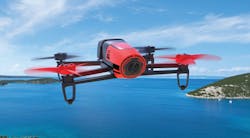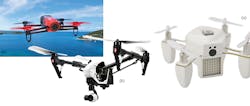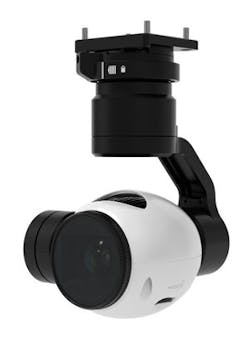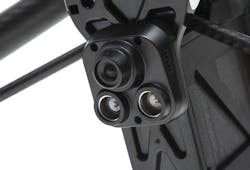Looking for a quadcopter? There are literally hundreds now available from a range of companies. Larger, higher-end drones often employ gas engines, but the plethora of small- to medium-size unmanned aircraft systems (UAS) use electric motors to lift the craft and provide an extremely stable platform.
There are fixed-wing and copter UAS systems. Fixed-wing systems typically have longer range and flight times, but copters have the ability to hover, move slowly. and rise vertically. While the typical UAS copter has four propellers, there are versions sporting any number of propellers. More are normally used for heavier payloads.
These electric drones are usually quiet. Unfortunately, they also tend to be limited by battery performance. Still, the increasing complexity of their on-board computers and their improved sensor systems make flying easier, even allowing for autonomous and semi-autonomous operation.
1. Parrot Bebop (a) has a front facing HD camera that uses digital image stabilization to providing a real time video feed to the remote pilot. DJI's Inspire 1 (b) transforms so the gimbaled camera has an unobstructed view allow dual user controls. One is for the aircraft and the other is for camera. The Zano (c) is an open source, tiny drone designed for research and hobbyists.
To get a flavor of what is available I take a look at the Parrot Bebop, the DJI Inspire 1, and the tiny Zano Micro Drone (Fig. 1). The Parrot Bebop is one most will notice because of Parrot’s distribution channels, as well as one of its target markets: consumers. Still, while its HD camera is capable of delivering professional-quality videos, the DJI Inspire 1 is likely to be the option professional videographers will consider. It has retractable landing gear to provide a clear 360-degree field of view for the gimbal-mounted that can be independently controlled.
The Zano Micro Drone is more of a research and hobbyist platform. It is not likely to be found at your local Target, but— based on what we saw at this year’s Consumer Electronics Show—there are a number of new drones in this class that might be, before long.
Download this article in .PDF format
This file type includes high resolution graphics and schematics when applicable.
Hi-Res Video with the Parrot Bebop
The Parrot Bebop may look like many other drones on the market but it takes digital approach to stable, streaming video. It starts with a fixed, 14 megapixel camera with a fisheye-lense that can record 1080p video. This provides a 180-degree field of view and allows for digital image stabilization.
The Bebop’s digital image stabilization is impressive because it is done on-board by Parrot’s P7 system-on-chip (SoC). The SoC has dual ARM Cortex-A9 cores and a quad core GPU. It also includes an image signal processor (ISP) that helps with the video heavy lifting. The SoC runs Linux and has 8 Gbytes of flash for storing videos. The 802.11 a/b/g/n/ac Wi-Fi support delivers streaming video to an app on a smartphone or tablet for first-person piloting. Many other UAS copters have line-of-sight (LoS) visual requirements.
The digital image stabilization provides a stable image on the controller display, as well as providing smooth recorded video. The stabilization is done by not presenting the full camera image, but rather, a subset that has been processed to eliminate both optics-related distortion and movement. While it is possible to get raw footage, the stabilized image makes more sense. This approach reduces the bandwidth needed to send video to the controller. It also provides a better view that helps when piloting the Bebop.
The copter has the usual 3D mix of accelerometers, gyros, and magnetometers. It also uses ultrasonics for elevation detection up to 8 m, along with a pressure sensor for altitude information. There is also a downward looking camera that analyzes the ground to determine horizontal speed and direction. In addition, it features GPS/GLONASS support. This allows for a return home option that can be initiated from the control panel.
The Bebop uses four three-blade propellers powered by three-phase, brushless motors. Flight time is just over 10 minutes. Batteries are easily swapped and two are included with the unit. The main cowling is magnesium, which acts as a heat sink. The foam propeller guards are optional and normally used indoors.
2. Parrot's Skycontroller holds a tablet and provides a pair of joysticks and status indicators.
The control application supports virtual touchscreen controllers. There is also the Skycontroller (Fig. 2), which holds a tablet still running the control application. An adjustable shade is above the tablet for outdoor use. The Skycontroller is compatible with 3D headsets like Oculus Rift, allowing for an immersive option; the Bebop view follows the movement of the headset. The Bebop is $499, while the addition of the Skycontroller increases this to $899.
Parrot provides an open-source SDK. This handles the Bebop and Skycontroller as well as other Parrot drones. The Bebop uses the MAVLink (Micro Air Vehicle Link), an open source protocol, from QgroundControl used by a number of small unmanned platforms. It is compatible with APM, Pixhawk, and the PX4 open-source, open-hardware autopilot project. Pixhawk can run on platforms like Linux, as well as platforms like NuttX RTOS that runs on microcontrollers like the STMicroelectronics STM32F series.
The Parrot Bebop camera can do limited panning without movement because the image presented is lower than what the camera captures. It has to turn to view something behind and it would have difficulty looking down.
The DJI Inspire 1 can do some of the camera tricks that Bebop cannot, owing to the DJI Inspire 1’s 3-axis, ZENMUSE X3 camera gimbal (Fig. 3). This type of camera mount is common especially on larger drones. It allow quick movement of the camera. Dynamic control of the joints can provide mechanical stabilization for the camera mount allowing almost any type of device to be used. For example, a conventional digital camera could be replaced by a thermal imaging system. The Inspire 1 has an angular vibration range of ±0.03 degess. The other advantage of this approach is that the entire image can be utilized, versus a digital approach where the perimeter must be reduced.
The X3 camera has a nin-element lens and a 12 Mpixel resolution. It can handle single images and burst mode, as well as video up to 4K at 30 frames/s. It can utilize a 64 Gbyte Micro SD card.
The Inspire 1 has the usual complement of sensors (including GPS) that is great for outdoor use, but not as much help indoors. This is where the Vision Positioning System (VPS) comes into play (Fig. 4). This is not an absolute location system like GPS: Rather, it tracks the vehicle’s surroundings, providing information to the autopilot to assist in providing a stable platform.
4. The Inspire's Vision Positioning System uses a camera and an ultrasonic sensor (the two circles on the bottom) to detect position changes.
The VPS includes a camera and an ultrasonic sensor. The ultrasonic sensor has a limited range but this is less of an issue indoors, especially in close quarters. The camera is used to detect movement in a fashion similar to the Bebop. In both cases, the camera software requires a view that has patterns it can detect, so it does not do well with a wall or floor that is very uniform in color. Mirrored or transparent surfaces do not work well either. A cluttered image, such as a carpet, works very well.
The other neat aspect of the Inspire 1 is its retractable landing gear. Actually, each pair of rotors is part of a frame that pivots up when flying and down when landing. This eliminates any vehicle obstructions from the viewing space of the camera regardless of where it is pointed.
The drone has a 5700 mAh, LoPo 65 battery that provides about 18 minutes of flight time. It has a 4500 m ceiling and a max ascent time of 5 m/s. It moves at speeds up to 22 m/s. It uses Wi-Fi communication.
The Inspire 1 uses two remote control units. One handles the flight controls while the other controls the camera. The system allows the two to operate independently of each other. The pilot uses LoS, although he can see what the camera is recording. The problem is that the camera may be looking in a direction other than what the pilot and control thinks is forward. The plus side is that a second person can concentrate on what is being framed by the camera instead of worrying about the orientation and position of the drone.
The reason for this approach is that one of the primary applications for the Inspire 1 is for movie making. It means that a qualified pilot can handle the flying, while a director or cameraman can work the camera. It is possible to use a single controller, as well.
Zano Micro Drone
The Zano Micro Drone is a Kickstarter project from the Torquing Group. The micro drone is designed for researchers and hobbyists. The software is open source and the small size, on 2.5-in by 2.5-in, also means a low-cost solution. Swarms of Zanos are not out of the question.
The Zano weighs only 55 grams, but has a 5 megapixel HD video camera, IR obstacle avoidance using four sets of sensors, plus ultrasonic sonar and a high resolution air pressure sensor to get altitude information. The camera can deliver 720p at 60 frames/s or 1080p at 30 frames/s. There is an on-board speaker driven by a 2 W Class D audio amplifier plus a high sensitivity digital microphone allowing for interesting video conferencing options.
Of course, the 8-by-8 color LED array is not quite up to video conferencing standards but it does provide better visual feedback than most drones. The array can also be used as a photo flash in addition to displaying information. This can be especially useful in swarms where particular drones need to be identified. The Zano also has multicolor landing lights.
The Zano may be small, but it has a top speed of 25 mph. It cannot get too far away since its flight time is restricted to a little over 10 minutes. There is a charging port and extra battery. Like the Parrot Bebop, the Zano uses digitally stabilized video, but it does not do it in real time. Instead it handles this in post processing using a supercomputer on the cloud. The video stream includes additional position information. The service is free, but has the advantage of putting a lot of compute power behind the camera ,but not in the air.
The Zano has a 330 DMIPS Microchip PIC32MZ microcontroller. This is a 32-bit, MIP-based processor. The system has bidirectional motor control using a full H-bridge. Other small, low-cost drones often use a single transistor. A microSD card provides storage. Lantronix supplies the xPico Wi-Fi module for the Zano. The 802.11b/g/n module has a 30 m range. There is also a low-bandwidth mesh networking module as well for communication with nearby Zano’s.
OriginGPS provides the small GPS module. It is actually cycled to reduce power as well as providing fast start-up. Of course, the system has the usual 3D magnetometer, accelerometer, and gyroscope subsystems.
Like the Bebop, the Zano is flown using an Android or iOS app on a smartphone or tablet. One of the more interesting features is the “Follow me” capability. The Zano will follow at a prescribed distance while using its collision avoidance sensors to stay clear of obstacles.
The software development kit (SDK) is divided into two major parts. The first addresses APIs used by control applications like the iOS and Android apps. The other is a set of high level hooks that can be used by scripting languages potentially allowing control of a Zano via a web application.
These three products hardly skim the growing population of quadcopters, but they do provide insight into the capabilities and trends. For example, the Parrot Bebop’s older sibling, the AR.Drone 2 (see “Smart phone Controls Low-Cost Quadrotor”), was larger, with a less-powerful processor and lower-resolution camera.
The Federal Aviation Administration’s (FAA) rules for commercial use of flying unmanned vehicles like these drones will be finalized soon. Developers and hobbyists have already been able to fly within certain limits already, but commercial use has been restricted. Still, the Bebop and Inspire 1 are likely to find uses in the commercial space, especially for filming.
Drones have progressed significantly over the years. The ability to pack more storage, sensors, and processing power into a smaller package has allowed vendors to deliver some amazing products like the Bebop, Inspire 1 and Zano. Still, there is a lot more to be done. Support like the Zano’s mesh networking is on the cutting edge of research—research that will eventually emerge in commercial implementations.
Don’t be surprised if one of the next generation quadcopters shows up ringed with 3D video cameras sporting multiple multicore processor chips.
This file type includes high resolution graphics and schematics when applicable.
About the Author
William G. Wong
Senior Content Director - Electronic Design and Microwaves & RF
I am Editor of Electronic Design focusing on embedded, software, and systems. As Senior Content Director, I also manage Microwaves & RF and I work with a great team of editors to provide engineers, programmers, developers and technical managers with interesting and useful articles and videos on a regular basis. Check out our free newsletters to see the latest content.
You can send press releases for new products for possible coverage on the website. I am also interested in receiving contributed articles for publishing on our website. Use our template and send to me along with a signed release form.
Check out my blog, AltEmbedded on Electronic Design, as well as his latest articles on this site that are listed below.
You can visit my social media via these links:
- AltEmbedded on Electronic Design
- Bill Wong on Facebook
- @AltEmbedded on Twitter
- Bill Wong on LinkedIn
I earned a Bachelor of Electrical Engineering at the Georgia Institute of Technology and a Masters in Computer Science from Rutgers University. I still do a bit of programming using everything from C and C++ to Rust and Ada/SPARK. I do a bit of PHP programming for Drupal websites. I have posted a few Drupal modules.
I still get a hand on software and electronic hardware. Some of this can be found on our Kit Close-Up video series. You can also see me on many of our TechXchange Talk videos. I am interested in a range of projects from robotics to artificial intelligence.





